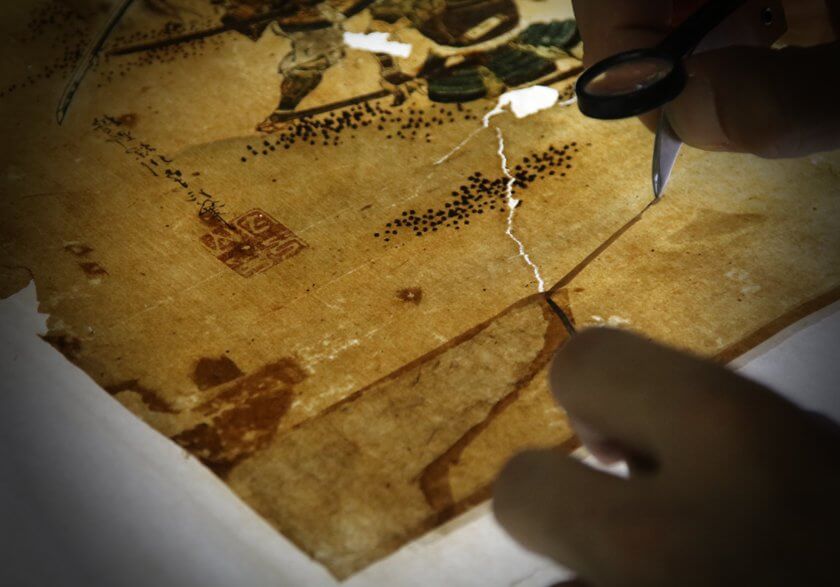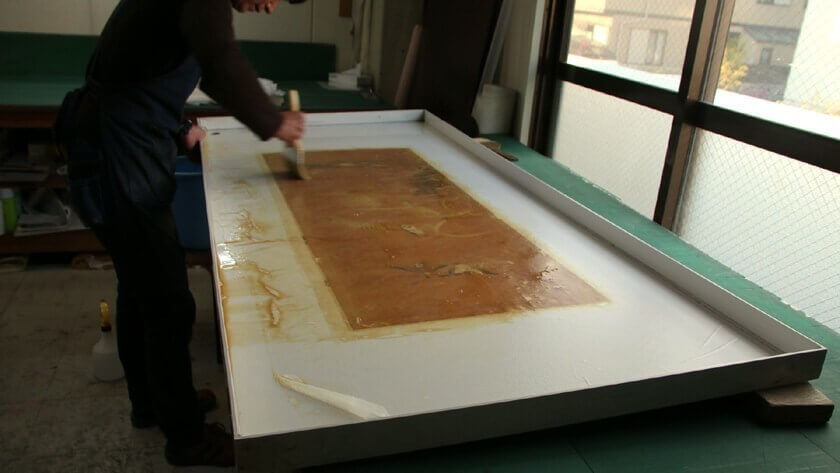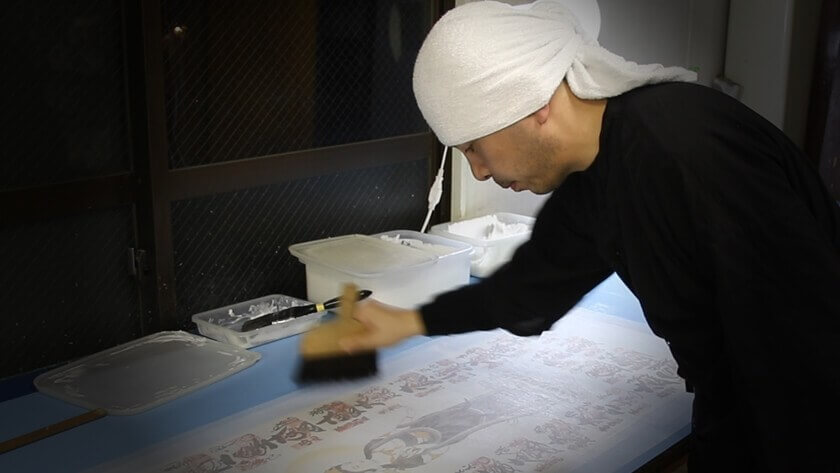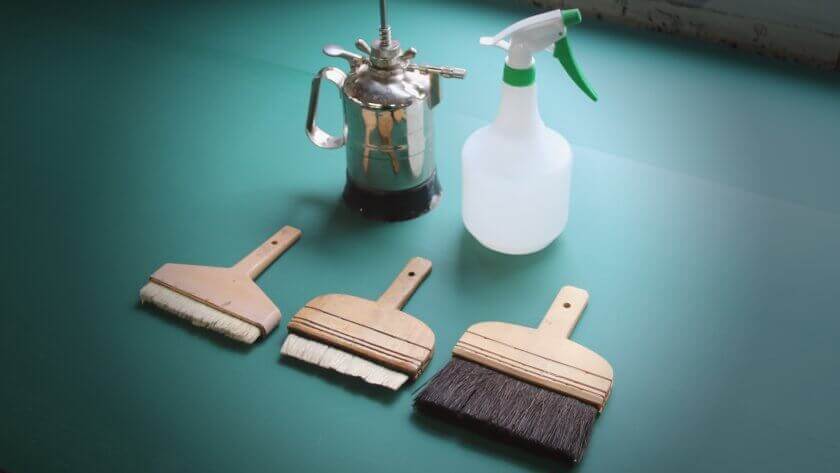4 Reasons Why You Should Seek a Professional to Have Stains Removed from Your Kakejiku Hanging Scroll.
Video: English Subtitle Available | 4 Reasons Why You Should Seek a Professional to Have Stains Removed from Your Kakejiku Hanging Scroll.
In this article, we are going to put forward four reasons why you should ask a professional to have stains removed from your hanging scroll.
We have received many inquiries about restorations of hanging scrolls, many of which concerns stains on them. Among the inquiries are questions whether there is a way to remove stains from a hanging scroll without seeking professional assistance.
It is totally understandable because the restoration of hanging scrolls is fairly expensive. However, from the perspective of professional mounters, we strongly recommend you do not by yourself.
The main reason is simply because it is very challenging. In order to avoid such mistakes, we would like to explain why it is better to leave the removal of stains from hanging scrolls to professionals. Even for professionals, removing stains is a delicate and nerve-wracking process, so it is not recommended you even think of trying.
The reason why we would like to raise this issue here is because people sometimes contact us to seek help after their attempts on removing stains have failed. In our honest view, it is much more straightforward to undertake the task without anything having been done beforehand.
Not only the extra work may cost more, but it is also a possibility that the stains may still not come off nicely. This is very true.
In order to avoid such mistakes, we would like to explain why it is better to leave the removal of stains from hanging scrolls to professionals.
1. The removal of stains cannot be done without disassembling the entire hanging scroll.

Many people who attempt to remove the stains on hanging scrolls believe that they can do so without disassembling them. The truth is that this is impossible.
The reason for this is that the process requires a chemical to remove stains. For example, bleach is used to remove stains from clothes. This is the same idea.
If a stain remover is applied on the hanging scroll without being disassembled first, parts to which the chemical is applied will develop white patches or be partially discoloured. As a result, the condition of the scroll will get worse.
In addition, hanging scrolls generally have three or four layers of backing paper pasted to the back of the paper where the picture is painted. This is called ‘urauchi’. When these layers are moistened, the adhesive strength of the paste where water is applied weakens, which causes air-pockets to be created between the layers.

Therefore, in order to remove stains from hanging scrolls, the backing paper must be peeled from the scroll. However, peeling off the old backing paper is very challenging even for professionals. If it is done without knowledge or forcibly, the artwork will more likely be torn or damaged. It is particularly harder when strong adhesive paste had been applied. This involves a delicate process to carefully remove the backing paper, only relying on the subtle sensations of your fingertips.
Recently, we repaired a hanging scroll depicting plum blossom from the UK. It was very time-consuming to peel off the old backing paper from the back of the scroll. Please watch the following video that shows how difficult the process was. (English Subtitle Available)
Although the old backing paper is moistened with water in order to peel it off, it may need a colour-fixing process, depending on how the paint or ink was applied. In fact, substantial experience is required to be able to judge whether the paint or ink on the surface is stable or not.
2. Complicated use of chemicals

It is necessary to use different types of chemicals, methods and techniques, depending on the condition of the stains.
The assessment of the situation is important since the stains will gradually disappear as the concentration of the chemical and the duration of its use change over time. The stains do not come off instantly with a chemical, so it is often the case that it takes longer than planned. It is not uncommon that the process requires more than an hour of work including examination, and if it is still not successful, then a different method will be employed on another day.
Professional mounters have a vast amount of experience in removing stains. We can determine instantly the best way to remove stains from the artwork by examining the condition of the scroll based on our experience. We will do our utmost to protect the artwork. Therefore, experience is absolutely essential for this process since the scroll gets damaged if cleaning process is overdone.
Professional mounters have full knowledge of what kind of problems chemicals can cause. We are really careful about removing stains and sometimes decide to stop doing so in the middle of the process. In the worst case scenario, an actual painting can be discoloured or even erased during the process. Hence, it is best to ask professionals.
3. Remounting has to be done

The first two points have explained how complicated removing stains can be, but let us assume that you did it all by yourself and the stains came out nicely.
Then, the real problem starts; the artwork has to be remounted. It is certainly difficult for you to do remounting unless you are skilled.
A totally different level of expertise and knowledge is required, much more than simply unscrewing an appliance and putting it back together again.
4. Difficulty in procuring the necessary chemicals and tools

Many chemicals and tools needed for the process can only be obtained from specialised shops. It is strongly recommended not to try to use substitutes, which will certainly cause problems.
Conclusion
I hope this helps you to understand the reasons why you should ask a professional to have stains removed from hanging scrolls.
The summary of four reasons is below.
- 1. The removal of stains cannot be done without disassembling the entire hanging scroll.
- 2. Complicated use of chemicals
- 3. Remounting has to be done
- 4. Difficulty in procuring the necessary chemicals and tools
It is true that the removal of stains is costly. Yet, we strongly recommend consulting with a professional as the whole process is complicated and also requires specialised skills, experience and knowledge.
Please feel free to contact us even if you do not live locally.
Please also watch the following video for more details about the process of removing stains from hanging scroll. (English subtitle available | Restoration Order from the U.S. : Removal of Stains)

